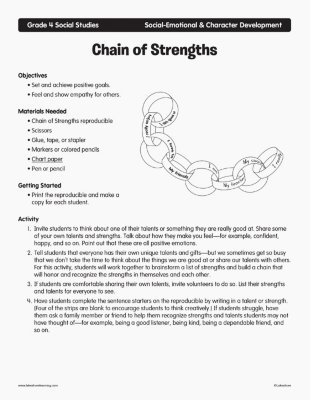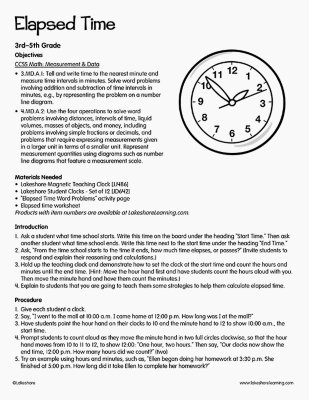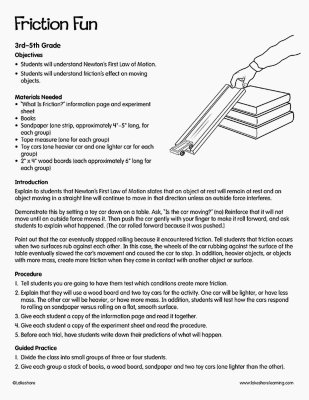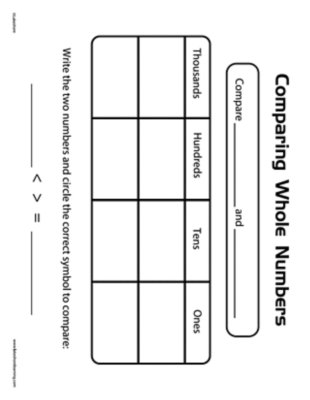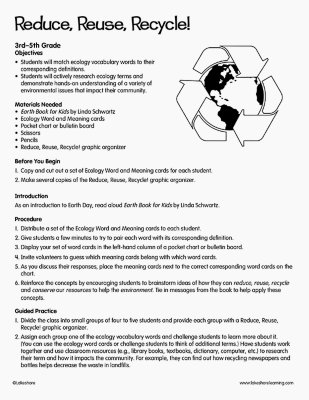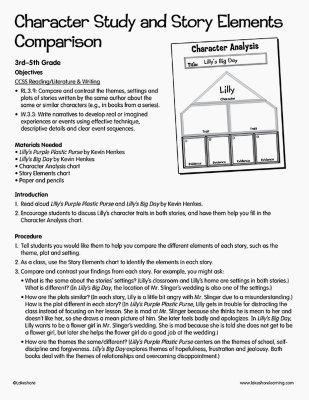Narrow by Grade
- Infant (0)
- Toddler (0)
- Preschool (0)
- Pre-K (0)
- Kindergarten (0)
- 1st (0)
- 2nd (0)
- 3rd (2)
- 4th (6)
- 5th (0)
- 6th & Up (0)
Grade
Narrow by Age
- 0-18m (0)
- 18-36m (0)
- 3 yrs. (0)
- 4 yrs. (5)
- 5 yrs. (10)
- 6 yrs. (9)
- 7 yrs. (7)
- 8 yrs. (4)
- 9 yrs. (6)
- 10 yrs. (0)
- 11 yrs. & Up (0)
Age 9 yrs.
0 results for "seating/" , here are results for "setting"
Filters
Clear All
Chain of Strengths
4th Grade
Objectives
- Set and achieve positive goals.
- Feel and show empathy for others.
Elapsed Time
3rd Grade - 4th Grade
Objectives CCSS Math: Measurement & Data 3.MD.A.1: Tell and write time to the nearest minute and measure time intervals in minutes. Solve word problems involving addition and subtraction of time intervals in minutes, e.g., by representing the problem on a number line diagram. 4.MD.A.2: Use the four operations to solve word problems involving distances, intervals of time, liquid volumes, masses of objects, and money, including problems involving simple fractions or decimals, and problems that require expressing measurements given in a larger unit in terms of a smaller unit. Represent measurement quantities using diagrams such as number line diagrams that feature a measurement scale. Materials Needed Lakeshore Magnetic Teaching Clock Lakeshore Student Clocks - Set of 12 “Elapsed Time Word Problems” activity page Elapsed time worksheet Introduction Ask a student what time school starts. Write this time on the board under the heading “Start Time.” Then ask another student what time school ends. Write this time next to the start time under the heading “End Time.” Ask, “From the time school starts to the time it ends, how much time elapses, or passes?” (Invite students to respond and explain their reasoning and calculations.) Hold up the teaching clock and demonstrate how to set the clock at the start time and count the hours and minutes until the end time. (Hint: Move the hour hand first and have students count the hours aloud with you. Then move the minute hand and have them count the minutes.) Explain to students that you are going to teach them some strategies to help them calculate elapsed time.
View Lesson PlanFriction Fun
4th Grade
Objectives Students will understand Newton’s First Law of Motion. Students will understand friction’s effect on moving objects. Materials Needed “What Is Friction?” information page and experiment sheet Books Sandpaper (one strip, approximately 4" - 5" long, for each group) Tape measure (one for each group) Toy cars (one heavier car and one lighter car for each group) 2" x 4" wood boards (each approximately 6" long for each group) Introduction Explain to students that Newton’s First Law of Motion states that an object at rest will remain at rest and an object moving in a straight line will continue to move in that direction unless an outside force interferes. Demonstrate this by setting a toy car down on a table. Ask, “Is the car moving?” (no) Reinforce that it will not move until an outside force moves it. Then push the car gently with your finger to make it roll forward, and ask students to explain what happened. (The car rolled forward because it was pushed.) Point out that the car eventually stopped rolling because it encountered friction. Tell students that friction occurs when two surfaces rub against each other. In this case, the wheels of the car rubbing against the surface of the table eventually slowed the car’s movement and caused the car to stop. In addition, heavier objects, or objects with more mass, create more friction when they come in contact with another object or surface.
View Lesson PlanComparing Whole Numbers
4th Grade
Objective CCSS Math: Number & Operations in Base Ten 4.NBT.A.2: Read and write multi-digit whole numbers using base ten numerals, number names and expanded form. Compare two multi-digit numbers based on meanings of the digits in each place, using >, =, and < symbols to record the results of comparisons. Materials Needed Interactive whiteboard or chalkboard Large number cards Cardstock or Construction Paper - 9" x 12" (optional) Place value charts Preparation Make two sets of the number cards. (For durability, you may want to mount them onto sturdy construction paper or cardstock and laminate them.) Introduction Display the following symbols on an interactive whiteboard or chalkboard: > Invite students to discuss what each symbol means (greater than, less than and equal to). Remind students that these symbols are used when comparing two numbers to determine which is larger (greater than) or smaller (less than) or if they are equal.
View Lesson PlanReduce, Reuse, Recycle!
4th Grade
Objectives Students will match ecology vocabulary words to their corresponding definitions. Students will actively research ecology terms and demonstrate hands-on understanding of a variety of environmental issues that impact their community. Materials Needed Earth Book for Kids by Linda Schwartz Ecology Word and Meaning cards Pocket chart or bulletin board Scissors Pencils Reduce, Reuse, Recycle! graphic organizer Before You Begin Copy and cut out a set of Ecology Word and Meaning cards for each student. Make several copies of the Reduce, Reuse, Recycle! graphic organizer. Introduction As an introduction to Earth Day, read aloud Earth Book for Kids by Linda Schwartz.
View Lesson PlanCharacter Study and Story Elements Comparison
3rd Grade - 4th Grade
Objectives CCSS Reading/Literature & Writing RL.3.9: Compare and contrast the themes, settings and plots of stories written by the same author about the same or similar characters (e.g., in books from a series). W.3.3: Write narratives to develop real or imagined experiences or events using effective technique, descriptive details and clear event sequences. Materials Needed Lilly’s Purple Plastic Purse by Kevin Henkes Lilly’s Big Day by Kevin Henkes Character Analysis chart Story Elements chart Paper and pencils Introduction Read aloud Lilly’s Purple Plastic Purse and Lilly’s Big Day by Kevin Henkes. Encourage students to discuss Lilly’s character traits in both stories, and have them help you fill in the Character Analysis chart.
View Lesson Plan